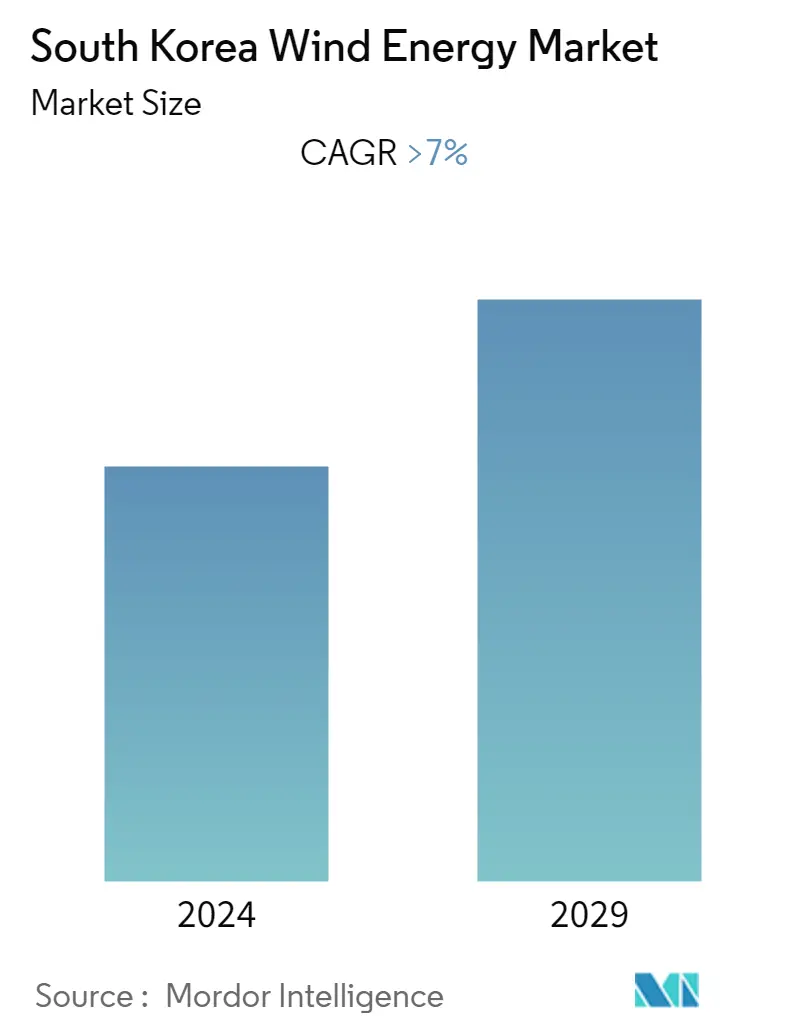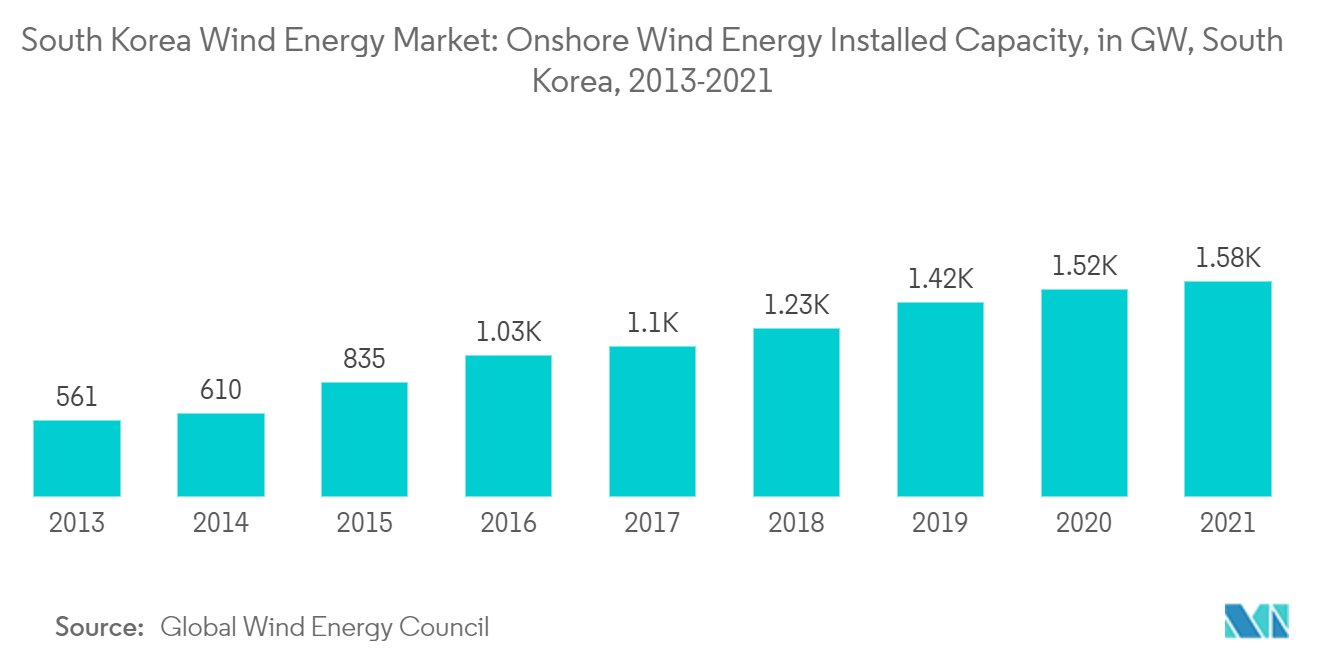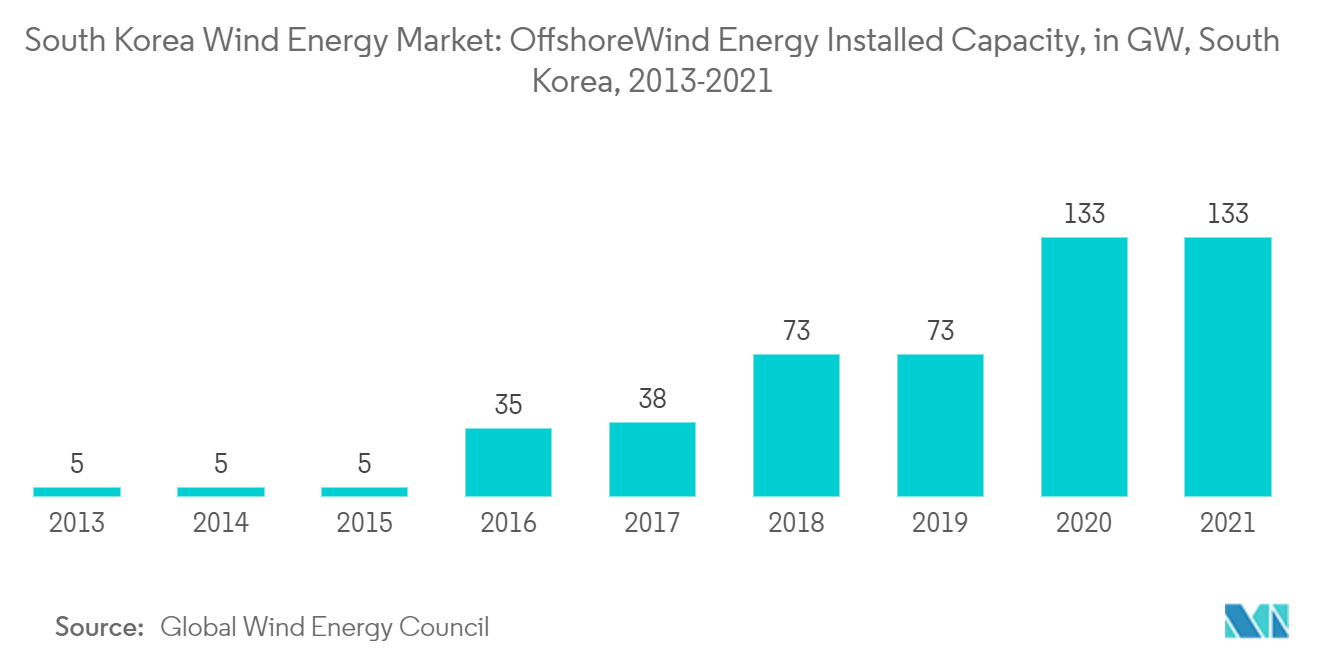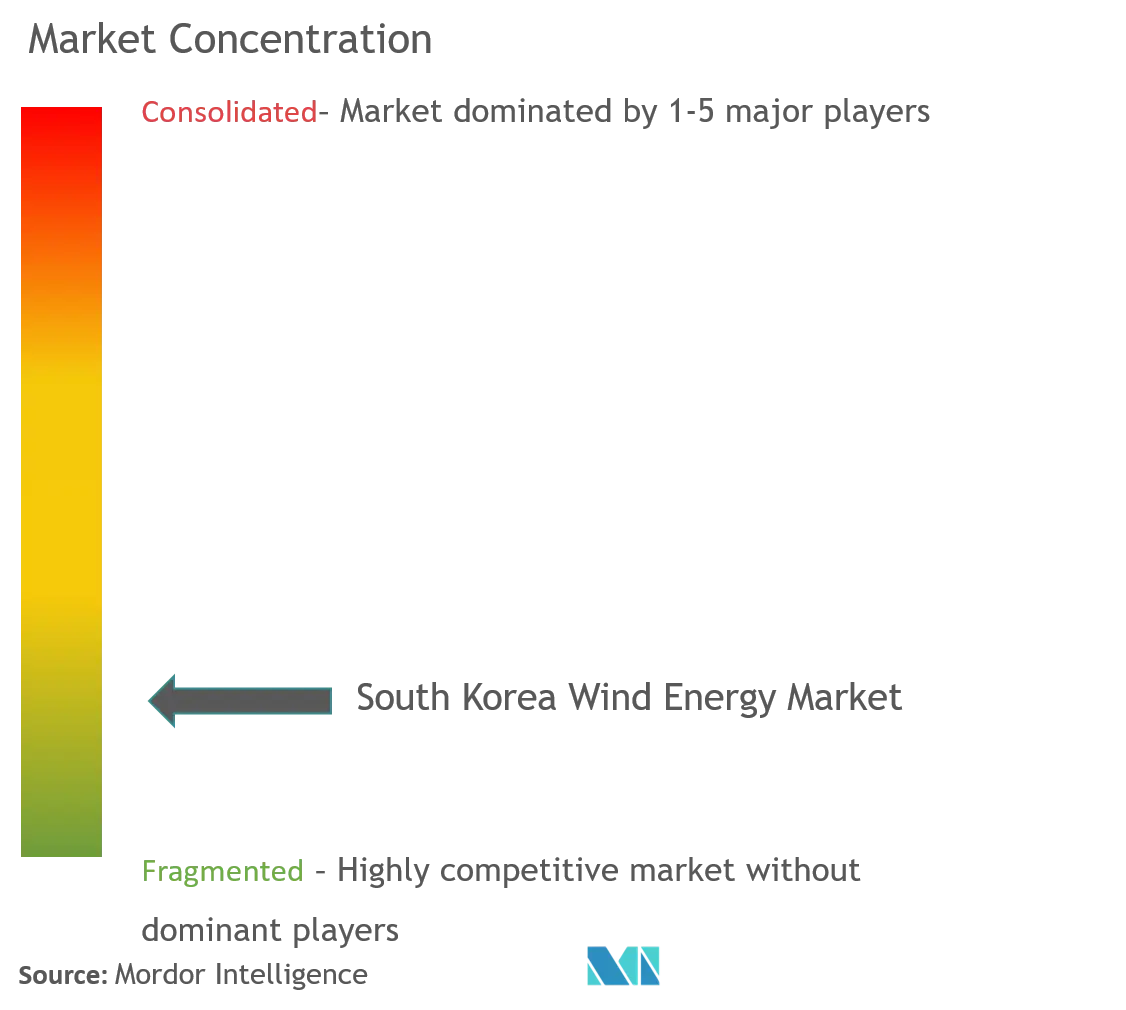South Korea Wind Energy Market Size

| Study Period | 2021 - 2029 |
| Base Year For Estimation | 2023 |
| Forecast Data Period | 2024 - 2029 |
| Historical Data Period | 2021 - 2022 |
| CAGR | 7.00 % |
| Market Concentration | Medium |
Major Players
*Disclaimer: Major Players sorted in no particular order |
South Korea Wind Energy Market Analysis
The South Korean wind energy market is projected to register a CAGR of over 7% during the forecast period.
COVID-19 negatively impacted the market in 2020. Presently the market has reached pre-pandemic levels.
Over the medium term, the primary driver for the market includes the government's efforts to reduce the dependency on fossil fuels and thereby improve the air quality of the country.
On the other hand, lack of investment, on account of the low rate of return on invested capital, is likely to hinder the market growth during the forecast period.
Nevertheless, with the objective of increasing its renewable share in the country's energy mix to 20% by 2030, South Korea is expected to increase its renewable capacity to 63.8 gigawatts by 2030. Moreover, wind energy in the country is expected to increase its capacity to nearly 17.7 GW by 2030, which is likely to create an opportunity for the market to grow in the near future.
South Korea Wind Energy Market Trends
This section covers the major market trends shaping the South Korea Wind Energy Market according to our research experts:
Onshore Wind Energy is Likely to Dominate the Market
As one of the largest economies in Asia-Pacific, South Korea has been pushing to reduce its heavy reliance on coal and nuclear power. In response to the rising environmental concerns, South Korea plans to boost the share of renewable power generation to as much as 35% by 2040. Further, the country's pledge to reach net zero by 2050 was a significant pronouncement from an Asian industrial powerhouse.
According to the country's third Energy Master Plan (EMP) 2019, the government aims to increase the share of renewable power from 6.5% to 20% by 2030 and 30-35% by 2040.
Onshore wind energy is the prominent segment in the South Korean wind energy sector that holds nearly 1.57 GW of installed capacity as of 2021. With an increase in demand for cleaner energy, the segment is expected to grow further with the implementation of new onshore wind projects.
Onshore wind turbines are easier to install and are low in investment compared to offshore. According to the Energy Information Administration (EIA), offshore wind is 2.6 times more expensive than onshore wind power. It is 3.4 times more expensive than power produced by a natural gas combined-cycle plant.
In July 2022, Total Eren, a renewable energy Independent Power Producer ('IPP'), announced the launch of construction and successful Financial Close of the 'Parang Wind Farm' with a capacity of 16.7 MW, together with its partners WEEN E&S and Korea Midland Power. The Parang Project is going to be located in Yeong-deok, on the East Coast of South Korea.
Thus, the completion of the under-construction and planned projects is likely to increase the overall onshore installed capacity and is expected to dominate the wind energy market of the country.

Upcoming Offshore Wind Projects to Drive the Market
The country has large onshore wind potential, but development has faced problems with complex permitting, local opposition, and growing grid connectivity issues. Thus, while onshore wind capacity is expected to increase, South Korea is turning to offshore wind as the big game changer, announcing some of the most ambitious projects in the world.
South Korea targets 9.2 GW of wind power by 2025 and 16 GW by 2030, of which 12 GW will comprise offshore wind. This may be an over-reach, considering the 1.579 GW of onshore wind and 133 MW of offshore wind installed in 2021. Although no new offshore wind projects were commissioned in South Korea in 2021, land-use constraints are shifting the focus from renewable energy to offshore wind power.
In June 2022, Siemens Gamesa and Doosan Enerbility signed a memorandum of understanding (MOU) concerning cooperation in offshore wind power activities in South Korea. This covers a potential collaboration in large-scale offshore wind turbines, construction of new production facilities, supply of wind turbine parts, offshore wind turbine installation, and turbine maintenance.
In January 2022, TUV SÜD Korea and Shinan-gun, a county on South Korea's southwest coast, signed a Memorandum of Understanding (MOU) with KEPCO KPS (Korea Electric Power Corporation's Plant Service & Engineering) to assist with the establishment of a plant operation and maintenance ecosystem for Shinan offshore wind farm. In the Shinan wind farm zone, up to 8.2 gigawatts of electricity are expected to be generated.
In January 2022, Ørsted signed a memorandum of understanding (MoU) with Korean state-owned utilities Korea Southern Power (KOSPO) and Korea Midland Power (KOMIPO) for the development of the 1.6 GW Incheon offshore wind project.
In October 2022, Elenergy Co. Ltd, a Korean renewable energy development company, appointed DNV as the owner's engineer for its 1.5 GW fixed-bottom Chujin offshore wind project. When completed in 2027, Chujin will be the world's largest commercial-scale offshore wind farm. DNV will be the owner's engineer responsible for driving the pre-Front End Engineering Design (FEED) and supervising contractors during the final design, procurement, construction, commissioning, and operation phases of the project to mitigate risks and prepare optimal solutions.
Moreover, with rising challenges like limited onshore land for setup onshore wind farms, the government concentration toward offshore is growing. It is likely to invest KRW multi-trillion toward R&D of wind technology, which will develop the offshore sector during the upcoming years.

South Korea Wind Energy Industry Overview
The South Korean wind energy market is moderately fragmented. The key players in the market include Equinor ASA, Vestas Wind Systems A/S, Siemens Gamesa Renewable Energy SA, Global Wind Energy Co. Ltd., and Hyosung Heavy Industries.
South Korea Wind Energy Market Leaders
-
Equinor ASA
-
Vestas Wind Systems A/S
-
Siemens Gamesa Renewable Energy SA
-
Global Wind Energy Co. Ltd
-
Hyosung Heavy Industries
*Disclaimer: Major Players sorted in no particular order

South Korea Wind Energy Market News
- July 2022: The Siemens Gamesa Company awarded a contract to supply 15 units of its SG 5.0-145 turbine to 75 MW Gunwi wind farm for its developer SK D&D. The project is expected to be commissioned in 2024.
- In November 2021, Korean East-West Power (EWP) and Equinor signed a Memorandum of Understanding (MoU) for the joint development of 3 GW of offshore wind projects in South Korea.
South Korea Wind Energy Market Report - Table of Contents
1. INTRODUCTION
- 1.1 Scope of the Study
- 1.2 Market Definition
- 1.3 Study Assumptions
2. EXECUTIVE SUMMARY
3. RESEARCH METHODOLOGY
4. MARKET OVERVIEW
- 4.1 Introduction
- 4.2 South Korea Renewable Energy Mix, 2021
- 4.3 Installed Capacity and Forecast in GW, till 2027
- 4.4 Recent Trends and Developments
- 4.5 Government Policies and Regulations
-
4.6 Market Dynamics
- 4.6.1 Drivers
- 4.6.2 Restraints
- 4.7 Supply Chain Analysis
- 4.8 PESTLE Analysis
5. MARKET SEGMENTATION
-
5.1 Location of Deployment
- 5.1.1 Onshore
- 5.1.2 Offshore
6. COMPETITIVE LANDSCAPE
- 6.1 Mergers and Acquisitions, Joint Ventures, Collaborations, and Agreements
- 6.2 Strategies Adopted by Leading Players
-
6.3 Company Profiles
- 6.3.1 Equinor ASA
- 6.3.2 Vestas Wind Systems A/S
- 6.3.3 Siemens Gamesa Renewable Energy SA
- 6.3.4 Global Wind Energy Co. Ltd
- 6.3.5 Hyosung Heavy Industries Corporation
- 6.3.6 Ørsted A/S
- 6.3.7 Vestas Wind Systems A/S
- 6.3.8 Total Eren SA
- 6.3.9 Elenergy Co. Ltd
- 6.3.10 TÜV SÜD
- *List Not Exhaustive
7. MARKET OPPORTUNITIES AND FUTURE TRENDS
** Subject To AvailablitySouth Korea Wind Energy Industry Segmentation
The wind is used to produce electricity by converting the kinetic energy of air in motion into electricity. By rotating the rotor blades, wind transforms kinetic energy into rotational energy. The rotational energy is transferred to the generator through a shaft, thereby generating electrical power.
The South Korean wind energy market is segmented by location of deployment. By location of deployment, the market is segmented into onshore and offshore. For each segment, the market sizing and forecasts have been done based on installed capacity (GW).
| Location of Deployment | Onshore |
| Offshore |
South Korea Wind Energy Market Research FAQs
What is the current South Korea Wind Energy Market size?
The South Korea Wind Energy Market is projected to register a CAGR of greater than 7% during the forecast period (2024-2029)
Who are the key players in South Korea Wind Energy Market?
Equinor ASA, Vestas Wind Systems A/S, Siemens Gamesa Renewable Energy SA, Global Wind Energy Co. Ltd and Hyosung Heavy Industries are the major companies operating in the South Korea Wind Energy Market.
What years does this South Korea Wind Energy Market cover?
The report covers the South Korea Wind Energy Market historical market size for years: 2021, 2022 and 2023. The report also forecasts the South Korea Wind Energy Market size for years: 2024, 2025, 2026, 2027, 2028 and 2029.
South Korea Wind Energy Industry Report
Statistics for the 2024 South Korea Wind Energy market share, size and revenue growth rate, created by Mordor Intelligence™ Industry Reports. South Korea Wind Energy analysis includes a market forecast outlook to 2029 and historical overview. Get a sample of this industry analysis as a free report PDF download.



